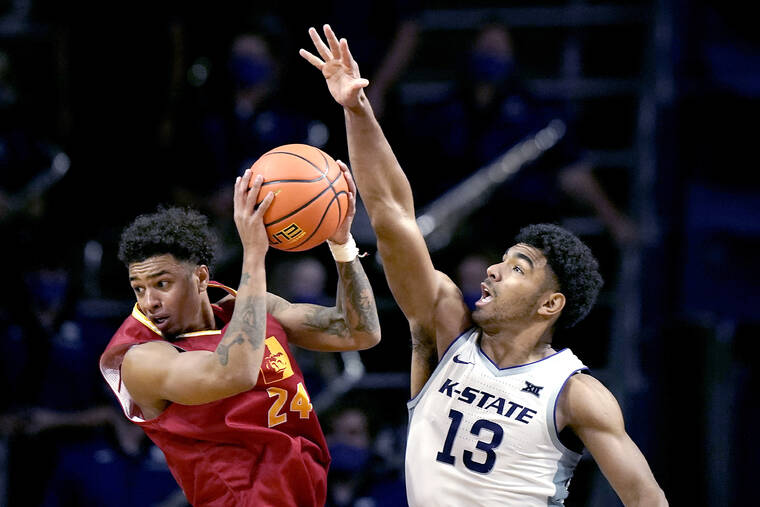Big 12 hoops could be winner in latest conference shuffle
LAWRENCE, Kan. — Kansas basketball coach Bill Self was so disgusted by the last round of conference realignment — when Missouri and Texas A&M bolted the Big 12 for the SEC — that he vowed never to play the Tigers again.
It didn’t matter that the Border War had been one of the best rivalries in college sports.
Self’s reason was simple: The departures, along with Nebraska’s move to the Big Ten and Colorado’s to the Pac-12, had left the Big 12 on precarious footing. Why continue with a treasured series with the league’s very existence on shaky ground?
The most recent round of conference realignment didn’t strike in Self nearly the same nerves. Perhaps because the Big 12 may have come out ahead — at least, when it comes to basketball.
Sure, the league will lose marquee names when Texas and Oklahoma leave for the SEC, but the football prowess of those two schools has historically outpaced their basketball pedigree.
Despite stars such as Kevin Durant and Buddy Hield over the years, the Longhorns have never won the Big 12 title and the Sooners haven’t won it since 2005. In fact, the two schools have only appeared in two national title games and never brought home a championship.
To replace them, the Big 12 is adding Houston, Cincinnati and Central Florida from the American Athletic Conference and BYU from the West Coast. The Bearcats have been to six Final Fours and delivered two national titles, Houston’s been to two title games and just went to the Final Four last season, and the Cougars are now a perennial NCAA tourney team.
“I think there was more concern in 2011, maybe because it was new, maybe because I was more involved,” said Self, who finally relented and allowed the Jayhawks to schedule a game against Missouri this season. “This time I wasn’t. I kind of felt like this time somehow it’d work out, it’d be figured out.”
It’s unclear exactly when the realignment will shake out. BYU has indicated it wants to begin play in the Big 12 in the fall of 2023 with the other three schools joining the following year, and Texas and Oklahoma are tied to their old league until 2025 for what amounts to an awkward lame-duck period that nobody is quite happy with.
For awhile, the Big 12 might balloon from 10 teams to 14 before settling back at … well, the Big 12. Even Commissioner Bob Bowlsby feels good about where the league stands, and that’s a pleasant change.
“Nobody has a better basketball tradition than Cincinnati. BYU has traditionally played in the Top 25, doing it coming out of a relatively mid-major league,” Bowlsby said. “I think in Houston’s case, their strength is self-evident. They were in the Final Four last year. UCF has had good teams as well, coached by my dear friend Johnny Dawkins.
“I think you don’t ever replace truly an Oklahoma and a Texas,” Bowlsby added, “but in the sport of basketball, I don’t think there’s any question that we don’t fall off much and we may gain.”
College basketball fans may ultimately gain, too.
Those in the SEC will enjoy the renewal of some old Southwest Conference rivalries — Texas will face Arkansas and Texas A&M again — and Oklahoma will face old Big Eight foe Missouri again. The league also will become the new home of the Red River Rivalry, which means a whole lot more in football but still has plenty of pizzazz on the hardwood.
The biggest loser might be Oklahoma State, which could lose its annual Bedlam rivalry with the Sooners. But there are major benefits for other schools in the Big 12: West Virginia finally gets a natural and geographic rival in Cincinnati, Texas schools get another in-state rival in Houston while Central Florida allows the league to expand its footprint into new television markets.
“I think it’s a great thing,” Horned Frogs coach Jamie Dixon said. “We landed on our feet really well.”
The trickle-down effect of conference realignment hasn’t been as kind to other leagues.
The AAC lost three of its premier programs, knocking the league down a notch in the eyes of many. Memphis expressed an interest in joining the Big 12 but has so far been passed over, while Wichita State left the Missouri Valley for the AAC with the expectation that it would be easier to earn an at-large NCAA tourney bid there — and now that may not be true.
The AAC has responded by raiding Conference USA to add UAB, Charlotte, Florida Atlantic, North Texas and UTSA. Conference USA in turn added Jacksonville State, Liberty, New Mexico State and Sam Houston.
There are many planned changes in mid- and low-major leagues, but they are in some ways just as important. Most of them are one-bid leagues, which means a tougher conference would in theory make it tougher for schools such as Austin Peay or Southern Utah, which announced a move to the WAC earlier this year, to reach the NCAA Tournament.
“All the analysis that we did, everything that we looked at — we just feel that this is a very good move for us, for the future of Southern Utah, for both the school and the athletic department,” athletic director Debbie Corum said. “As I told our coaches, we don’t have a crystal ball to know what the future brings, but if we didn’t think this was a really great move, we wouldn’t be making it.”
The Thunderbirds are far from the only schools making moves these days.


